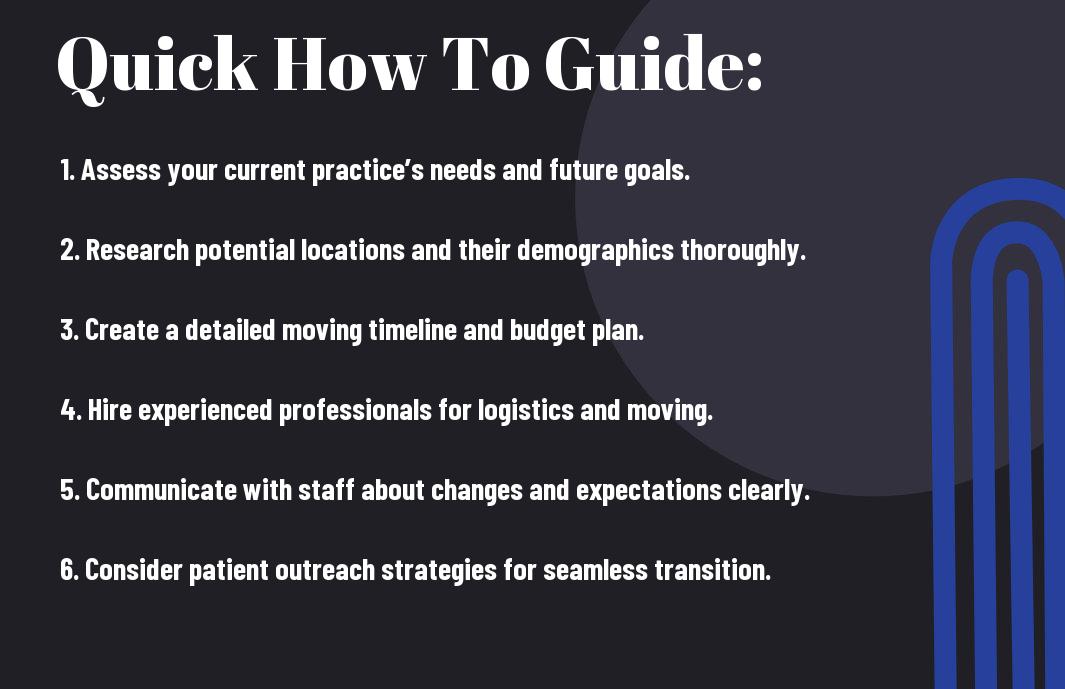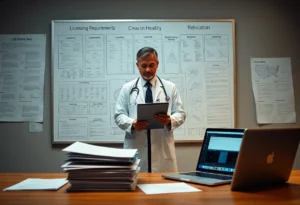Most physicians find relocating their practice to be a daunting task filled with numerous challenges to navigate. With the right strategies and insights from seasoned experts, you can turn this complex process into a seamless transition. In this guide, you’ll discover imperative tips for planning your move, ensuring minimal disruption to your services and maintaining patient satisfaction. By following these expert recommendations, you can successfully relocate your medical practice while keeping your focus on what truly matters: your patients and their care.

Understanding the Factors
While planning a successful move for your medical practice, it’s imperative to consider a range of factors that will impact your transition. Prioritize the following elements:
- Demographics of the new location
- Competition within the area
- Accessibility for your patients
- Local healthcare regulations
- Cost of living and overhead expenses
Thou must evaluate these aspects to ensure a seamless relocation.
Assessing Location Needs
Some key considerations in determining your ideal location include the population density, economic stability, and community health needs. Evaluating these facets will help you understand whether your specialty can thrive in the upcoming market.
Evaluating Practice Size and Specialty
Factors such as the size of your practice and the specific medical specialty you offer can significantly inform your relocation strategy. A larger practice requiring greater space might benefit from suburban areas that facilitate expansion, whereas specialized services may thrive in urban centers with higher patient volumes.
Location plays an imperative role in your medical practice’s success. You should consider demographics, local hospitals, and physicians in your specialty to secure a favorable position. Additionally, understanding the needs of both existing and potential patients can guide you in choosing a spot that complements your practice size, ensuring maximum accessibility and growth opportunities.
Creating a Moving Strategy
Any successful move for your medical practice begins with a comprehensive moving strategy. This involves identifying priorities, assessing your current facilities, and determining the requirements for your new location. A well-structured plan will help mitigate chaos and ensure a smooth transition for both your staff and patients, enabling you to focus on maintaining quality care during this process.
Setting a Timeline
To effectively manage your relocation, it’s important to set a clear timeline. Start by identifying key milestones, such as when to notify your patients and staff, finalizing the new lease, and scheduling the moving day. Allow enough time for potential delays, ensuring that every aspect of the move is addressed well in advance.
Budgeting for Relocation Costs
Assuming you want to avoid surprises, it’s vital to budget for all anticipated relocation costs. This includes expenses like hiring movers, purchasing new equipment, and potential renovations for your new space. Carefully estimating these costs upfront will help you allocate resources effectively and prevent overspending during the relocation process.
Timeline management plays a significant role in budget adherence. By assigning estimated costs to each phase of your relocation timeline, you can gain insights into your spending patterns and adjust as needed. Consider incorporating a contingency fund within your budget to address any unexpected expenses that may arise during the moving process, ensuring you remain aligned with your financial goals.
Choosing the Right Movers
For a seamless relocation of your medical practice, selecting the right movers is fundamental. Professionals with experience in transporting medical equipment and sensitive records will ensure your practice transitions smoothly, minimizing disruption to your workflow. Pay close attention to their specialization in handling medical logistics and their understanding of compliance issues specific to your industry.
Researching Professional Movers
On your quest for the right moving company, begin by researching professionals with a proven track record in medical relocations. Look online for reviews and testimonials from other medical practices that highlight their efficiency, reliability, and handling of medical equipment. Ensure you compile a list of potential movers who are accustomed to the unique challenges of relocating healthcare facilities.
Checking References and Credentials
Choosing a mover with solid references and credentials offers peace of mind. Always request reports of past projects, client testimonials, and any certifications that validate their experience in medical relocations. This will help ensure that the company you consider is equipped to handle specific requirements, such as maintaining confidentiality and adhering to regulations related to health data management.
To assess a moving company’s credibility, take the time to verify their references directly. Call previous clients and inquire about their experiences, focusing on the mover’s timeliness, professionalism, and care in handling sensitive equipment. Additionally, ensure they possess the necessary licenses and insurance, which provide you protection in the event of unforeseen issues during the move. By thoroughly vetting your options, you can confidently select a mover that aligns with your practice’s unique needs.
Informing Patients and Staff
Unlike other businesses, the success of your medical practice relies heavily on the trust and loyalty of your patients and staff. Approaching them with transparency and empathy about your move is necessary. Provide advance notice and clearly explain how the relocation will affect them, ensuring they feel valued and reassured throughout the process.
Communication Strategies
You should leverage multiple communication channels to ensure your message reaches everyone effectively. Consider using newsletters, personal emails, social media updates, and in-office announcements. This multifaceted approach helps to keep patients and staff informed about key details, from the timeline of the move to any changes in services offered.
Managing Expectations
Little can disrupt the flow of your medical practice like unexpected changes. Addressing and managing expectations early on can ease anxieties among patients and staff as you prepare to relocate.
To manage expectations effectively, engage in proactive dialogue with your stakeholders. Clearly outline what they can anticipate during the transition period, including potential disruptions to services and timelines. Offering reassurance that their care remains your priority will foster trust. Regular updates throughout the moving process will further help alleviate concerns and maintain confidence in your practice’s commitment to quality patient care.

Preparing for the Move
Once again, meticulous planning is imperative when preparing for the relocation of your medical practice. Start by creating a comprehensive timeline that outlines each step, from notifying your staff and patients to coordinating the logistics of the move. In this phase, communication with all parties involved, including vendors and regulatory agencies, will be key to a seamless transition. Ensure that your team is engaged and informed throughout the process to mitigate any potential disruptions to patient care.
Organizing Medical Equipment and Supplies
Clearly, organizing your medical equipment and supplies should take precedence during your preparation phase. Begin by inventorying items, categorizing them based on type and function, and labeling everything properly. This will not only streamline the packing process but also help in ensuring that all imperative tools are easily accessible when you arrive at your new location. A coordinated effort in this stage can save you significant time and reduce the stress often associated with relocation.
Compliance with Regulations
On the topic of compliance with regulations, you need to stay informed about the various codes and laws that may affect your move. This encompasses licensing requirements, patient privacy laws, and other legal obligations. Engaging with legal counsel and regulatory bodies will help ensure that your new practice meets all necessary guidelines and avoids potential issues that could arise during or after your move.
To ensure compliance with regulations during your relocation, it’s important to conduct thorough research on state and local laws applicable to your medical practice. This includes verifying that your new facility meets healthcare standards for safety and accessibility, as well as updating your practice’s licensing and insurance information. Additionally, be proactive in informing patients about the move and managing their records according to HIPAA regulations. By taking these steps, you can maintain the integrity of your practice and foster trust with your patients as you transition smoothly into your new space.
Post-Move Assessment
To ensure your medical practice thrives after relocation, conducting a post-move assessment is important. This process involves evaluating various aspects of your new environment to identify successes and areas for improvement. By thoroughly analyzing factors such as patient satisfaction, operational efficiency, and team dynamics, you can make informed decisions to enhance your practice’s performance and ensure a smooth transition for both staff and patients.
Evaluating Patient Flow
While assessing patient flow in your new location, pay attention to how efficiently patients navigate through your office. Observe the check-in process, waiting times, and appointment scheduling to identify any bottlenecks or delays. Learning how the layout impacts patient movement allows you to make necessary adjustments that enhance the overall patient experience and operational efficiency.
Gathering Feedback from Staff
Staff feedback is a vital component of your post-move assessment. Engaging your team in open discussions about their experiences in the new space can provide insights into potential challenges and successes. Encourage an environment where every staff member feels comfortable sharing their thoughts, as this will foster collaboration and lead to improvements in workflow, communication, and patient care.
Feedback from your staff can reveal their perspectives on the new office layout, equipment functionality, and workflow efficiency. Their firsthand experiences are invaluable for pin-pointing specific issues and determining what systems work well and what needs adjustment. Conducting regular check-ins, anonymous surveys, or team meetings will help you gather comprehensive input that will contribute to refining operations and promoting a productive atmosphere for both staff and patients.
Final Words
So, as you initiate on planning a successful move for your medical practice, utilizing expert tips can significantly ease the process. By carefully assessing your needs, communicating effectively with your staff, and organizing logistics ahead of time, you can ensure a seamless transition. Stay focused on minimizing disruptions to your patient care and maintaining your practice’s reputation. With proper planning and execution, your relocation can become a smooth and positive experience for both you and your patients.




